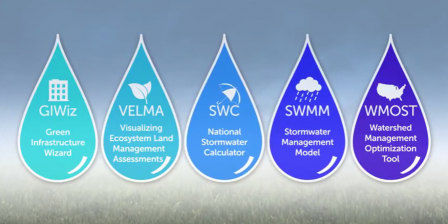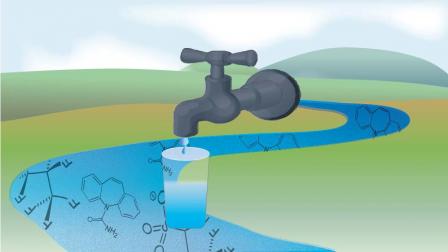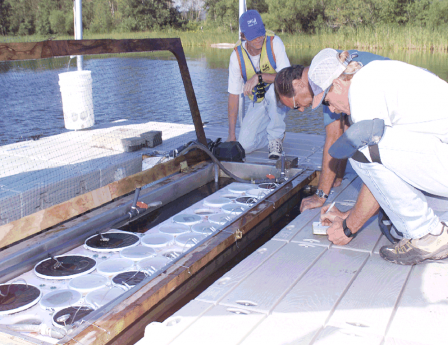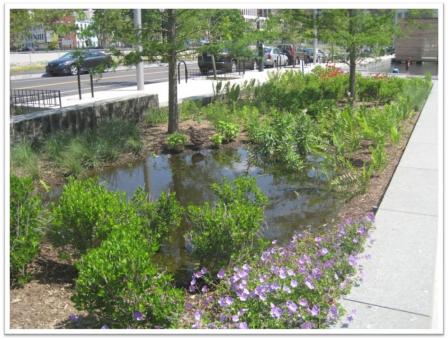Water Research Webinar Series
Safe and Sustainable Water Resources Research Program
EPA's Office of Research and Development is hosting monthly webinars to share information on its Safe and Sustainable Water Resources Research Program. Through innovative science and engineering, EPA’s scientists and engineers are developing cost-effective, sustainable solutions to 21st century complex water issues. These solutions will help ensure that clean and adequate supplies of water are available to support human health and resilient aquatic ecosystems, now and into the future. Research is conducted in partnership with other EPA programs, government agencies, nongovernmental organizations, public and private stakeholders, and the global scientific community.
EPA’s Safe and Sustainable Water Resources Strategic Research Action Plan, 2016–2019, outlines the topics and the overall structure and purpose of the Agency’s water research program. The scientific results and innovative technologies developed will support EPA’s mandate to protect the chemical, physical, and biological integrity of the Nation’s waters and to ensure safe drinking water and water systems.
Schedule and Registration (Subject to change)
- January 25, 2017 - Rapid Benefit Indicators Approach: A Process for Assessing the Social Benefits of Ecological Restoration

Ecological restoration can reestablish ecosystem services that provide important social benefits. Also, managers with limited funds and resources often need to prioritize potential restoration sites for implementation. Prioritizing restoration sites based on ecological functioning and expected ecosystem services production alone neglects vital information for evaluating tradeoffs—for example, determining who benefits from the resulting ecosystem services and by how much. The EPA developed Rapid Benefit Indicators (RBI) approach is an easy-to-use process for assessing restoration sites using non-monetary benefit indicators. The RBI approach uses readily-available data to estimate and quantify benefits to people around an ecological restoration site using ecosystem service benefit indicators based on economic principles. The framework uses five questions to guide the process of indicator selection and measurement:
- Can people benefit from an ecosystem service?
- How many people benefit?
- How much are people likely to benefit?
- What are the social equity implications?
- How reliable are benefits expected to be over time?
This webinar will present the RBI approach and its application to wetland restoration using an example application to freshwater wetland restoration in the Woonasquatucket River Watershed in Rhode Island. We will describe the RBI approach, its guidebook, and companion tools. The companion spreadsheet checklist tool, which provides a way to record benefit indicator information to compare sites, will also be demonstrated.
About the Presenters
Dr. Marisa Mazzotta - Dr. Mazzotta is an Environmental Economist with EPA’s Office of Research and Development’s National Health and Environmental Effects Research Laboratory-Atlantic Ecology Division. Her research has focused on non-market valuation of natural resources and environmental amenities, coastal, estuarine and marine ecosystem management, natural resource damage assessment, benefit-cost analysis, analysis of natural resource restoration, and interdisciplinary approaches to valuation of ecosystem services. Dr. Mazzotta is currently working on projects that are evaluating benefits of water quality improvements in coastal watersheds. Before coming to EPA, she conducted numerous policy and regulatory analyses as a consultant to government agencies and non-governmental organizations, and as an expert in litigation support, and has been a research and adjunct faculty member at the University of Rhode Island. Dr. Mazzotta received her Master's and Ph.D. degrees from the University of Rhode Island, and her Bachelor's degree from Brown University.
Justin Bousquin - Justin is a Social Scientist with EPA’s Office of Research and Development (EPA-ORD). His research combines economics and ecology to develop approaches and spatial tools that inform environmental decision making.
- February 22, 2017 - To be determined
Registration and additional information coming soon.
- April 26, 2017 - To be determined
Registration and additional information coming soon.
- June 28, 2017 - To be determined
Registration and additional information coming soon.
- August 30, 2017 - To be determined
Registration and additional information coming soon.
- October 25, 2017 - To be determined
Registration and additional information coming soon.
- December 13, 2017 - To be determined
Registration and additional information coming soon.
Past Webinars
- Systems View of Nutrient Management: Nutrient Recovery from Human Urine (December 14, 2016)
Urine is the primary source of phosphorus and nitrogen in municipal wastewater. Accordingly, it is important to consider for nutrient management. This webinar covered new science on recovering nutrients from human urine. This included issues of source separation in buildings, use at the farm, review of health issues, and factors influencing the environmental sustainability of nutrient management strategies. This webinar is an output of preliminary scientific research and demonstrations achieved from the Centers for Water Research on National Priorities Related to a Systems View of Nutrient Management, which were funded by EPA's Science to Achieve Results (STAR) grants.
Agenda and Presenters
1. Introduction: A brief introduction on the topic will be provided.
Presented by Dr. Colleen Naughton, University of South Florida, National Center for Reinventing Aging Infrastructure for Nutrient Management
Dr. Naughton is a postdoctoral research associate in Civil and Environmental Engineering at the University of South Florida where she also serves as the administrative assistant for the National Center for Reinventing Aging Infrastructure for Nutrient Management. Her research is focused around the food-water-energy nexus and coupling natural and human systems, integrating environmental sustainability and ethnographic analyses with local and global issues of sustainable development.2. Building: Waterless urinals can serve a two-fold benefit of water conservation and implementation of urine source separation system. However, due to urine’s composition and the presence of the urease enzyme that hydrolyzes urea, valuable nutrients readily precipitate in the urinal fixtures and pipes. This hinders both water conservation and nutrient recovery efforts because of maintenance problems. This presentation reviewed controlled laboratory experiments and a demonstration study that increases our understanding of the urea hydrolysis process in waterless urinals by mimicking and inhibiting urea hydrolysis so as to benefit water conservation and nutrient recovery.
Presented by Dr. Treavor Boyer, Arizona State University, National Center for Reinventing Aging Infrastructure for Nutrient Management
Dr. Boyer is an associate professor on the School of Sustainable Engineering and the Built Environment at Arizona State University. Before joining ASU, he was an Associate Professor in the Department of Environmental Engineering Sciences at the University of Florida. His research is broadly focused on water sustainability, and spans drinking water and wastewater treatment, and natural aquatic systems.
3. Environmental Sustainability: Nutrients embedded in wastewater or stormwater can be managed via different technologies at different scales. The factors influencing environmental sustainability of nutrient management strategies, including end applications, design configurations, implementation locations, and scale of implementations w discussed.
Presented by Dr. Qiong Zhang, University of South Florida, National Center for Reinventing Aging Infrastructure for Nutrient Management
Dr. Zhang is an associate professor of Civil and Environmental Engineering at the University of South Florida. Prior to joining USF, she worked as the operations manager for the Sustainable Futures Institute at Michigan Tech. She has sponsored research projects in the areas of green engineering and sustainability, life cycle assessment, waste-based resource recovery, system modeling of environmental technology adoption and critical infrastructures resiliency, and carbon footprint accounting of water and wastewater technologies and strategies.4. Health: Source separated urine typically contains pharmaceuticals and microorganisms. A review of the occurrence of pharmaceuticals and microorganisms in source separated urine as it is transformed into fertilizer products was provided. The impact of storage, struvite precipitation, and pasteurization on the levels and types of contaminants in urine has been studied.
Presented by Dr. Krista Wigginton, University of Michigan, WE&RF's National Research Center for Resource Recovery and Nutrient Management
Dr. Wigginton is an assistant professor of Civil and Environmental Engineering at the University of Michigan. Prior to joining the faculty at UM, she was an assistant professor at the University of Maryland, College Park. Her research focuses on applications of environmental biotechnology in drinking water and wastewater treatment. In particular, her research group develops new methods to detect and analyze the fate of emerging pollutants in the environment.
5. Farm: Source separated urine has been shown to work well as a crop fertilizer. Work on applying urine-derived fertilizer products to grow crops on a research farm in Vermont was discussed. Urine was collected from public toilets (>1,000 users) and turned into fertilizer. Lettuce and carrots were grown over two seasons in test field plots amended with urine, urine spiked with additional pharmaceuticals, urine-derived struvite, and synthetic fertilizer.
Presented by Abraham Noe-Hays, Rich Earth Institute, WE&RF's National Research Center for Resource Recovery and Nutrient Management
Mr. Noe-Hays is a founder of the Rich Earth Institute and has been working with dry sanitation systems since 1990. He holds a BA in Human Ecology with concentrations in agroecology and compost science from the College of the Atlantic, where his interest in recycling human manure led to an internship at Woods End Research Laboratory and his thesis project, “An Experiment in Thermophilic Composting.”
- Toolkit of Available EPA Green Infrastructure Modeling Software (October 26, 2016)
Note: A recording and presentation slides will be made available at a later date.
Stormwater discharges continue to cause impairment of our Nation’s waterbodies. Conventional stormwater infrastructure, or gray infrastructure, is largely designed to move stormwater away from urban areas through pipes and conduit. Runoff from these surfaces can overwhelm sewer systems and end up contaminating local waterways. When stormwater runs off impervious streets, parking lots, sidewalks, and rooftops, it carries pollutants, such as motor oil, lawn chemicals, sediments, and pet waste to streams, rivers, and lakes. Runoff flows can also cause erosion and flooding that can damage property, infrastructure, and wildlife habitat. In addition to runoff problems, impervious surfaces also prevent water from penetrating the soil and recharging groundwater supplies.

Green infrastructure (e.g., rain gardens, green roofs, porous pavement, cisterns) is becoming an increasingly attractive way to reduce the amount of stormwater runoff that flows into wastewater treatment plants or into waterbodies untreated, and to recharge aquifers. It provides many environmental, social, and economic benefits that promote urban livability, such as improved surface water quality, water conservation, and improved aesthetic and property value. Green infrastructure is also incorporated into municipal separate storm sewer system (MS4) and National Pollutant Discharge Elimination System (NPDES) stormwater permits for retention requirements for various states across the Nation. EPA researchers in the Office of Research and Development (ORD) have been studying green infrastructure practices and developing models and tools to help communities manage their stormwater runoff and address nutrient impairment. This webinar presented a toolkit consisting of five EPA green infrastructure models and tools, along with communication material, that can be used as a teaching tool and as a quick reference resource for use by planners and developers when making green infrastructure implementation decisions, and can also be used for low impact development design competitions. The models and tools included are the Green Infrastructure Wizard (GIWiz), Watershed Management Optimization Support Tool (WMOST), the Visualizing Ecosystem Land Management Assessments (VELMA) Model, the Storm Water Management Model (SWMM), and the National Stormwater Calculator (SWC).
About the Models/Tools and Presenters:
1. Green Infrastructure Wizard (GIWiz): GIWiz is an interactive web application that provides users with customized reports containing the EPA tools and resources they select, direct links, and overview information about each.
Presented by Dr. Marilyn Tenbrink (Contact: tenbrink.marilyn@epa.gov)
Dr. Marilyn Tenbrink is a Special Assistant to the Director of the Atlantic Ecology Division (AED) of EPA's National Health and Environmental Effects Research Laboratory (NHEERL) in Narragansett, Rhode Island. She received her Ph.D. in Environmental Geochemistry from Columbia University, New York, and has over 35 years of research experience on pollutant distribution, impacts, and management for aquatic systems. Marilyn is currently leading an interdisciplinary group of scientists to develop tools, including GiWIZ, that enable communities to better utilize Green Infrastructure approaches and improve sustainability.2. Watershed Management Optimization Support Tool (WMOST): WMOST is a software application designed to facilitate integrated water resources management across wet and dry climate regions. It allows water resources managers and planners to screen a wide range of practices across their watershed or jurisdiction for cost-effectiveness and environmental and economic sustainability. WMOST allows users to select up to fifteen stormwater management practices, including traditional grey infrastructure, green infrastructure, and other low impact development practices.
Presented by Dr. Naomi Detenbeck (Contact: detenbeck.naomi@epa.gov)
Dr. Naomi Detenbeck is an ecologist in NHEERL AED in Narragansett, RI, with an adjunct faculty appointment in Natural Resources Science at the University of Rhode Island. Her current research is focused on the watershed-scale effects of natural and constructed green infrastructure, development of decision-support tools for integrated water resources management, such as WMOST, and development of EPA’s Estuary Data Mapper. Naomi’s past research has included work on biogeochemistry, wetlands, landscape ecology, nutrient criteria development, and watershed classification. She earned her M.S. and Ph.D. in Ecology from the University of Minnesota.3. Visualizing Ecosystems for Land Management Assessment (VELMA) Model: VELMA is a computer software model that regional planners and land managers can use to quantify the effectiveness of natural and engineered green infrastructure management practices for reducing nonpoint sources of nutrients and contaminants in streams, estuaries, and groundwater. These practices include riparian buffers, cover crops, and constructed wetlands.
Presented by Dr. Bob McKane (Contact: mckane.bob@epa.gov)
Dr. Bob McKane is a Research Ecologist with NHEERL’s Western Ecology Division in Corvallis, Oregon. He received his Ph.D. in Soil Science from the University of Minnesota, and has over 25 years of experience in the use of simulation models for analyzing effects of climate, soils, and land use on biogeochemical and hydrological processes. Bob is currently leading an interdisciplinary group of scientists to develop and apply the VELMA ecohydrology model, which is currently being used by EPA’s ORD and Regions 7 and 10, tribes, and community groups to evaluate the effectiveness of alternative green infrastructure scenarios for improving water quality and ecosystem service co-benefits.4. Storm Water Management Model (SWMM): SWMM is a software application that is used widely throughout the world for large-scale planning, analysis, and design related to stormwater runoff, combined and sanitary sewers, and other drainage systems in urban areas – although there are many applications for drainage systems in non-urban areas as well. It allows users to represent combinations of green infrastructure practices to determine their effectiveness in managing runoff. SWMM was developed to help support local, state, and national stormwater management objectives to reduce runoff through infiltration and retention.
Presented by Dr. Michael Tryby (Contact: tryby.michael@epa.gov)
Dr. Michael Tryby joined the Water Supply and Water Resources Division in EPA's National Risk Management Research Laboratory located in Cincinnati, Ohio in September 2011. He holds a B.S. in Civil Engineering and an M.S. in Environmental Engineering from the University of Cincinnati, where he worked on drinking water treatment for disinfection byproduct control and systems analysis of water distribution system disinfection practices. Michael received his Ph.D. in Civil Engineering from North Carolina State University while working in commercial software development as a water distribution modeling domain expert. His immediate responsibilities include work on modeling green infrastructure and low impact development best management practices using EPA’s SWMM 5.0.5. National Stormwater Calculator (SWC): SWC is a desktop application that estimates the annual amount of stormwater runoff from a specific location in the United States (including Puerto Rico), based on local soil conditions, land cover, and historic rainfall records. It is used to inform site developers on how well they can meet a desired stormwater retention target with and without the use of green infrastructure. It also allows users to consider how runoff may vary based both on historical weather and potential future climate. SWC is a resource for all Rainwater Management Credits in LEED by the U.S. Green Building Council for all project types in all rating systems.
Presented by Jason Berner (Contact: berner.jason@epa.gov)
Jason Berner is trained as a landscape architect and has been with EPA for over nine years. He has worked in EPA’s Region 2 and Office of Water, and is currently working as a biologist in ORD. His research focuses on the application of green infrastructure planning tools, urban planning and design, community capacity building with municipalities and utilities, and supporting innovative water technologies. Jason has a Master of Landscape Architecture and a B.S. in Environmental Sciences from the University of Illinois at Urbana-Champaign.
- Valuing Ecosystem Services Generated by Nutrient Reductions - A Spatial Approach (August 31, 2016)

Agricultural Best Management Practices (BMPs) aimed at reducing nutrient and sediment loads play an important role in meeting goals to restore ecosystem function in the Chesapeake Bay. However, those BMPs also affect water quality in contributing rivers. As part of the Penn State Center for Nutrient Solutions, we have developed a spatial model of ecosystem services generated by the water quality improvements in rivers and streams contributing to the Chesapeake Bay that result from BMPs applied to agricultural lands. This model accounts for where the BMPs are situated, the impact they have on the immediate watershed, and the impact reduced loadings have on downstream rivers and the Chesapeake Bay. The model also accounts for where people are located relative to the improved water bodies, and the resulting ecosystem services they enjoy. The model can serve as a prototype for a BENMAP-type tool applied to surface water.
About the Presenter
Richard Ready, Ph.D. (Contact: richard.ready@montana.edu)
Dr. Ready is Professor of Environmental Economics at Montana State University, and Associate Director of the Montana Institute on Ecosystems. His research focuses on measuring and valuing ecosystem services affected by environmental policies and natural resource use. He received his Ph.D. in Agricultural and Resource Economics from University of Wisconsin. Dr. Ready has served on the editorial board of the American Journal of Agricultural Economics and Land Economics, and currently serves on the EPA Science Advisory Board Environmental Economics Advisory Committee. He is also associated with the Pennsylvania State University Center for Integrated Multi-scale Nutrient Pollution Solutions, which is one of four center grants awarded in 2013 under EPA’s National Priorities grant program.
- Contaminants of Emerging Concern (CECs) in Source and Treated Drinking Water (June 29, 2016)

Contaminants of emerging concern (CECs) is a term which encompasses a vast array of chemicals such as pharmaceuticals, perfluoroalkyl substances, and surfactants, as well as microorganisms such as Mycobacteria and Legionella. These contaminants end up entering the water cycle, either through municipal or household use (entering the grey water), or excretion (entering the black water). CECs can survive wastewater treatment, and end up in surface waters, along with other contaminants which may run off of the land into the watershed. This water can be the drinking water source for a downstream community. Scientists from EPA and the U.S. Geological Survey have collaborated on a study examining the occurrence of CECs both in source water and treated drinking water from drinking water treatment plants from across the United States. This presentation discussed the occurrences of the chemical and microbial contaminants measured in the study, and examined the implications for aquatic life and human health.
About the Presenter
Susan Glassmeyer, Ph.D. (Contact: glassmeyer.susan@epa.gov)
Dr. Glassmeyer is a research chemist in EPA/ORD’s National Exposure Research Laboratory, where her research is focused on both chemical and microbial CECs in the water cycle. She has coordinated several projects examining the occurrence, fate and transport of CECs in wastewater, surface water, ground water, and drinking water. Dr. Glassmeyer earned a B.S. in Chemistry from Xavier University, and a M.S. in Environmental Science and a Ph.D. from Indiana University.
- Assessment of Major Ion Effects on Aquatic Organisms (April 27, 2016)

Natural geochemical weathering introduces several inorganic ions to natural waters, primarily Na+, K+, Ca2+, Mg2+, Cl-, SO42-, and HCO3-/CO32-. These ions not only define the basic chemistry of surface waters, but they also have physiological roles and are actively regulated by aquatic organisms. However, several land uses, including energy and mineral extraction, can increase concentrations of these geochemical ions to concentrations that pose ecological risks, either through direct discharge of process or waste waters, of by accelerating geochemical weathering. The ecological effects of increased ion concentrations are being explored through several inter-related research efforts that span levels of biological organization from physiological through field community levels. Research to date demonstrates that these effects are dependent on both the specific ions that are elevated, and on the background composition of the receiving water. This webinar provided an overview of EPA’s research in this area, and some of the implications for predicting ecological risks and informing management decisions.
About the Presenter
David Mount, Ph.D. (Contact: mount.david@epa.gov)
Dr. David Mount joined EPA’s Office of Research and Development as a research aquatic biologist in 1995. He received his Ph.D. from the University of Wyoming in 1987, where his dissertation focused on the effects of surface water acidification on the reproductive physiology of fish. Prior to joining EPA, Dave worked for five years in the private sector and two years conducting research for the Department of the Interior. Dave’s research has covered a variety of topics in environmental toxicology, including the bioavailability of environmental contaminants, methods to test and evaluate sediment contamination, assessing and modeling effects of chemical mixtures, and the effects of dietary exposure to contaminants. He often provides technical advice to EPA Regional and Program Office staff, particularly in areas of water quality criteria, toxicity test methods, and ecological risk assessment under the Superfund, RCRA, and FIFRA programs.
- Financing Opportunities for Implementing Green Infrastructure Projects to Manage Stormwater (February 24, 2016)

Presentation 1: (Presented by Joshua Kurtz, The Nature Conservancy). The Nature Conservancy is working across the country on leveraging existing, and developing new innovative approaches, to finance and deploy green infrastructure projects to manage stormwater. This presentation provided an overview of work done around the country that enables the utilization of public and private funding sources to implement green infrastructure in order to create the greatest ecological, economic and social benefits. A discussion on how the Conservancy is exploring ways to share lessons learned and best management practices across multiple jurisdictions and municipalities was also provided.
Presentation 2: (Presented by Holly Galavotti, EPA's Office of Wastewater Management). This presentation provided an overview of innovative financing for green infrastructure programs and highlight low-cost, state- of-the-art financing opportunities for green infrastructure projects through State Revolving Funds. EPA’s new Water Infrastructure and Resiliency Finance Center was also discussed. This center of financial expertise is a resource to communities who are exploring options for financing resilient drinking water, wastewater, and stormwater infrastructure. It is working to promote innovative financing approaches and expand capacity building efforts through collaborative technical assistance, specifically on how to best support communities to develop dedicated sources of revenue for their stormwater and green infrastructure programs
About the Presenters
Joshua Kurtz (Contact: jkurtz@tnc.org)
Josh is a policy analyst with The Nature Conservancy’s MD/DC Chapter working on stormwater management policies and regulations that allow for leveraging private investment for green infrastructure deployment in the Chesapeake Bay watershed. Josh also works on a team evaluating stormwater management policies across the country, focusing on innovative funding mechanisms.
Holly Galavotti (Contact: galavotti.holly@epa.gov)
Holly has worked at EPA for 11 years. She currently works in the Office of Wastewater Management on the municipal stormwater permit program and coordinates with regions, states, municipalities, and other stakeholders on implementing the program. Holly also works with EPA’s new Water Infrastructure and Resiliency Finance Center, where she focuses on providing information and technical assistance to communities on stormwater and green infrastructure financing. Holly has a master's degree in environmental sciences from the University of Virginia and a bachelor’s degree in biology from James Madison University.


















